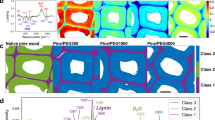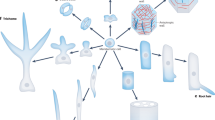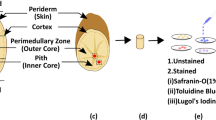Abstract
ALTHOUGH it is almost eighty years since Nägeli1 introduced the micellar hypothesis to account for the anisotropy of certain plant structures, it is remarkable how nearly his original conception satisfies the most recent discoveries. It may be recalled that Nageli pictured the cell wall as composed of ultra-microscopic particles to which he gave the name 'micelles', and which were regarded as discrete units, more or less like the bricks in a masonry wall. In order to explain the shrinkage of wood it was assumed that water entered or left the intermicellar spaces, pushing the micelles farther apart or allowing them to come nearer together, and the elongated shape of the micelles was held to account for the difference between longitudinal and transverse shrinkage; the optical anisotropy of the cell wall was referred to the optical properties of the micelles themselves. Some revision of Nageli's statement was however found necessary, and a large body of workers rejected the conception completely, postulating instead a system of continuous or connected cellulose threads or layers. Neither conception is completely satisfactory and the modern tendency is to seek a compromise between the two. The position has been reviewed from the point of view of physicist, chemist and botanist2,3,45, perhaps the fullest summaries being those of Frey-Wyssling5*, which have been freely used in the present account.
This is a preview of subscription content, access via your institution
Access options
Subscribe to this journal
Receive 51 print issues and online access
$199.00 per year
only $3.90 per issue
Buy this article
- Purchase on SpringerLink
- Instant access to full article PDF
Prices may be subject to local taxes which are calculated during checkout
Similar content being viewed by others
References
Nägeli, C., "Die Micellartheorie". Edited by A. Frey-Wyssling. (Leipzig, 1928.)
Anderson, D. B., Bot. Rev., 1, 52–76 (1935).
Astbury, W. T., "The Fundamentals of Fibre Structure" (Oxford University Press, 1933).
Seifriz, W., Protoplasma, 21, 129–159 (1934).
Frey-Wyssling, A., Protoplasma, 25, 261–300 (1936); 27, 372, 563 (1937); Ber. deutsch. Bot. Ges., 55, 119–132 (1937).
Young, G. H., and Rowland, B. W., Paper Trade J., 97, 15–44 (1933) (cited by A. J. Bailey, Mikrochimica Acta, 2, 35–36 (1937)).
Staudinger, H., and Sorkin, M., Melliand Textilber., 18, 681–4 (1937).
Barkas, W. W., Proc. Phys. Soc., 48, 576–588 (1936).
Kerr, T., and Bailey, I. W., J. Arn. Arb., 15, 327–349 (1934).
Clarke, S. H., Forestry, 9, 132–138 (1935).
Bailey, I. W., and Kerr, T., J. Arn. Arb., 16, 273–300 (1935); 18, 261–272 (1937).
Anderson, D. B., and Kerr, T., Ind. and Eng. Chem., 30, 48–54 (1938).
Ritter, G. J., and Stillwell, C. W., Paper Trade J., 98, 37–40 (1934).
Ritter, G. J., Ind. Eng. Chem., 20, 941–945 (1928); Paper Industry, 16, 178–183 (1934).
Farr, W. K., and Eckerson, S. H., Contrib. Boyce Thompson Inst., 6, 189–203 (1934).
Author information
Authors and Affiliations
Rights and permissions
About this article
Cite this article
CLARKE, S. Fine Structure of the Plant Cell Wall. Nature 142, 899–904 (1938). https://doi.org/10.1038/142899a0
Issue date:
DOI: https://doi.org/10.1038/142899a0
This article is cited by
-
A zoom into the nanoscale texture of secondary cell walls
Plant Methods (2014)
-
Cell walls and synthetic fibers
Economic Botany (1947)



